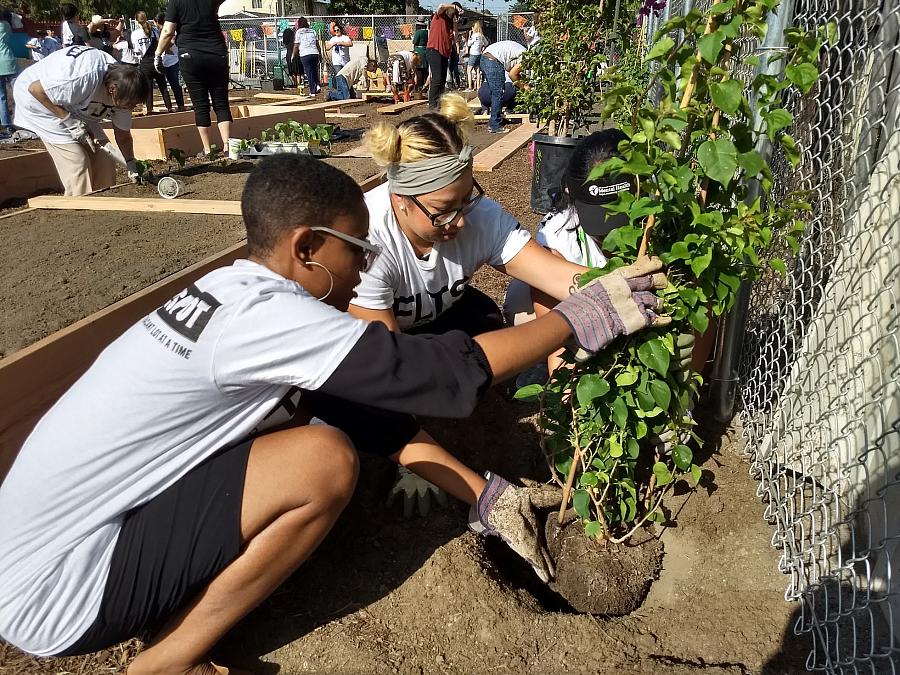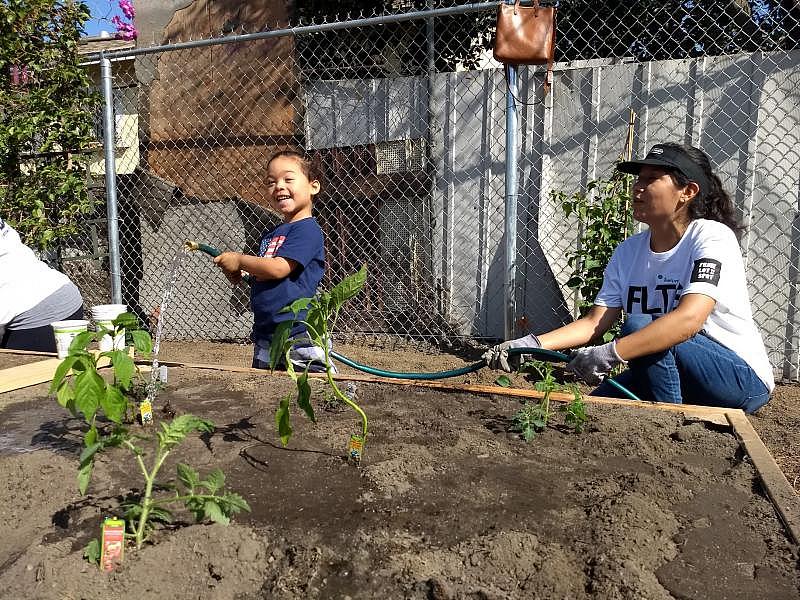Gardening for mental health? L.A. County tries new strategy in Watts

Volunteers help build a new garden and green space in Watts last month. (Photos courtesy L.A. County Department of Mental Health)
On a vacant lot in a neighborhood bordering the community of Watts in South Los Angeles, a homeless encampment had sprouted in recent years. Then drug dealers came in brandishing guns and threats and scared the homeless people away.
Dread and danger spread like weeds across Wilmington Avenue. Mothers stopped taking children on late afternoon walks. Neighbors stayed inside homes. When Nancy Ciszczon's husband told her that a drug dealer pulled a gun on him, she’d had enough. She called Los Angeles County officials with a threat of her own: If something isn't done with the old vacant property, she said she told them, she and her family would leave.
To her surprise, someone at the the Los Angeles County Department of Mental Health heard her. A flyer was left on her gate not long after her call: A community garden was coming, it announced. Neighbors watched over the summer as charred remains of old burned-out cars were hauled out of the vacant lot. Seeds and soil came next. New life was brought to the tired patch of land on Wilmington Avenue and with it, a growing sense of relief.
The new garden, which officially opened in September, is part of a broader response to a recent study in the Journal of the American Medical Association. Through a randomized control trial in Philadelphia, researchers found that the mental health of residents in urban neighborhoods can be improved by cleaning up and “greening” vacant lots. Residents who lived nearby experienced “a significant reduction in feeling depressed and worthless,” the researchers wrote.
“The results of this study are remarkable and a wakeup call to remind us how important the health of our neighborhood can be to our own sense of wellbeing,” Mimi Martinez McKay, deputy director of the LA County Department of Mental Health, said in a statement. “So many factors contribute to mental health problems and we need multiple prevention strategies," she added. “This program is so simple, with proven benefits at a relatively low cost.”
The $50,000 used to clean the 6,500-square-foot lot and provide supplies came from the Mental Health Services Act, passed by California voters in 2004. Under the act, a 1 percent tax is levied on people who earn more than $1 million annually to pay for expanded mental health care services and programs statewide. Martinez McKay said the Watts garden is the first of many blighted and abandoned lots the county plans on greening across Los Angeles.
For the Watts project, county officials partnered with From Lot to Spot, a local nonprofit organization that works to turn vacant lots into parks and gardens in underserved communities. The Watts lot was purchased for $1 a year for five years through a lease agreement between the owner, the organization and the county.
“We have long seen the negative impact that blighted vacant lots have on the health and mental wellness of communities,” said the nonprofit’s executive director Viviana Franco, adding that the group will work with the community to keep the garden going.
The idea of improving urban neighborhoods with gardens and small parks isn’t new. Ron Finley, a nationally known Los Angeles-based artist, designer and “guerilla gardener” started by planting the median strip in front of his house in South L.A. before taking his message to “plant some shit” to the TED talk stage and beyond. “Gardening is the most therapeutic and defiant act you can do,” he said in one of his talks.
The recent JAMA study by a team of physicians, epidemiologists and criminologists appears to validate Finley’s message. The team monitored the changes in Philadelphia residents after blighted, vacant lots were transformed with greenery. They noted a 42 percent decrease in feelings of depression and saw a 63 percent drop in self-reported “poor mental health” for those living near greened lots, compared to a control group in similar neighborhoods where blighted lots were left untouched.

“The remediation of vacant and dilapidated physical environments, particularly in resource-limited urban settings, can be an important tool for communities to address mental health problems, alongside other patient-level treatments,” the JAMA researchers wrote.
The study garnered national attention, said researcher Dr. Eugenia South, one of the study’s authors and an assistant professor of emergency medicine at the Perelman School of Medicine at the University of Pennsylvania. “I do know there are several cities who have ongoing projects, such as Flint, Michigan, Youngstown, Ohio, and New Orleans, Louisiana,” she said.
Compared to other areas in Los Angeles County, Watts and its surrounding communities have fewer parks and open space where residents can visit. A recent health profile of South Los Angeles found 17 percent of all adults are at risk of suffering from depression, the highest among all other areas, compared to 12 percent adults for all of Los Angeles County. At the same time, 40 percent of all adults in South Los Angeles feel their neighborhoods are safe, compared to 84 percent overall, according to the profile, compiled by the Los Angeles County Department of Public Health.
Ciszczon, 40, said she often drives several miles to buy fruits and vegetables in bulk, which she shares with family members. She said she hopes the new garden will lessen the lack of fresh foods in the area. She’s also looking forward to start growing her favorites: zucchini and Mexican squash in one of 26 raised planting beds. The community garden also will include a tool shed, a collective cooking space and murals.
Ciszczon said she can't wait to share her vegetables and old gardening tips her mother once taught her as a child, when many families still grew their own food in South Los Angeles, not far from where she lives now.
“For me, I feel like the community can now come together and share my bounty,” she said."I know I'm not going to eat all that zucchini.”
**

